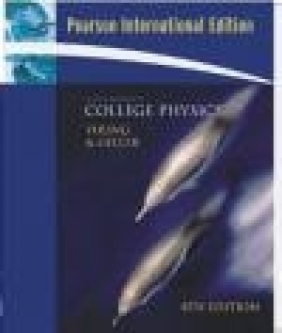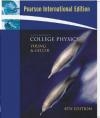College Physics with Mastering Physics
Robert Geller, Hugh D. Young, H Young
College Physics with Mastering Physics
Robert Geller, Hugh D. Young, H Young
- Producent: Addison Wesley Publishing Company
- Rok produkcji: 2005
- ISBN: 9780321373137
- Ilość stron: 1180
- Oprawa: brak formatu
Niedostępna
Opis: College Physics with Mastering Physics - Robert Geller, Hugh D. Young, H Young
For more than five decades, Sears and Zemansky's College Physics has provided the most reliable foundation of physics education for students around the world. For the Eighth Edition, Robert Geller joins Hugh Young to produce a comprehensive update of this benchmark text. A broad and thorough introduction to physics, this new edition carefully integrates many solutions from educational research to help students to develop greater confidence in solving problems, deeper conceptual understanding, and stronger quantitative-reasoning skills, while helping them connect what they learn with their other courses and the changing world around them.Chapter 1 Models, Measurements, and Vectors 1.1 Introduction 1.2 Idealized Models 1.3 Standards and Units 1.4 Unit Consistency and Conversions 1.5 Precision and Significant Figures 1.6 Estimates and Orders of Magnitude 1.7 Vectors and Vector Addition 1.8 Components of Vectors Chapter 2 Motion along a Straight Line 2.1 Displacement and Average Velocity 2.2 Instantaneous Velocity 2.3 Average and Instantaneous Acceleration 2.4 Motion with Constant Acceleration 2.5 Proportional Reasoning 2.6 Freely Falling Objects *2.7 Relative Velocity along a Straight Line Chapter 3 Motion in a Plane 3.1 Velocity in a Plane 3.2 Acceleration in a Plane 3.3 Projectile Motion 3.4 Uniform Circular Motion *3.5 Relative Velocity in a Plane Chapter 4 Newton's Laws of Motion 4.1 Force 4.2 Newton's First Law 4.3 Mass and Newton's Second Law 4.4 Mass and Weight 4.5 Newton's Third Law 4.6 Free-Body Diagrams Chapter 5 Applications of Newton's Laws 5.1 Equilibrium of a Particle 5.2 Applications of Newton's Second Law 5.3 Contact Forces and Friction 5.4 Elastic Forces 5.5 Forces in Nature Chapter 6 Circular Motion and Gravitation 6.1 Force in Circular Motion 6.2 Motion in a Vertical Circle 6.3 Newton's Law of Gravitation 6.4 Weight 6.5 Satellite Motion Chapter 7 Work and Energy 7.1 An Overview of Energy 7.2 Work 7.3 Work and Kinetic Energy 7.4 Work Done by a Varying Force 7.5 Potential Energy 7.6 Conservation of Energy 7.7 Conservative and Nonconservative Forces 7.8 Power Chapter 8 Momentum 8.1 Momentum 8.2 Conservation of Momentum 8.3 Inelastic Collisions 8.4 Elastic Collisions 8.5 Impulse 8.6 Center of Mass 8.7 Motion of the Center of Mass *8.8 Rocket Propulsion Chapter 9 Rotational Motion 9.1 Angular Velocity and Angular Acceleration 9.2 Rotation with Constant Angular Acceleration 9.3 Relationship between Linear and Angular Quantities 9.4 Kinetic Energy of Rotation and Moment of Inertia 9.5 Rotation about a Moving Axis Chapter 10 Dynamics of Rotational Motion 10.1 Torque 10.2 Torque and Angular Acceleration 10.3 Work and Power in Rotational Motion 10.4 Angular Momentum 10.5 Conservation of Angular Momentum 10.6 Equilibrium of a Rigid Body *10.7 Vector Nature of Angular Quantities Chapter 11 Elasticity and Periodic Motion 11.1 Stress, Strain, and Elastic Deformations 11.2 Periodic Motion 11.3 Energy in Simple Harmonic Motion 11.4 Equations of Simple Harmonic Motion 11.5 The Simple Pendulum 11.6 Damped and Forced Oscillations Chapter 12 Mechanical Waves and Sound 12.1 Mechanical Waves 12.2 Periodic Mechanical Waves 12.3 Wave Speeds *12.4 Mathematical Description of a Wave 12.5 Reflections and Superposition 12.6 Standing Waves and Normal Modes 12.7 Longitudinal Standing Waves 12.8 Interference 12.9 Sound and Hearing 12.10 Sound Intensity 12.11 Beats 12.12 The Doppler Effect 12.13 Applications of Acoustics *12.14 Musical Tones Chapter 13 Fluid Mechanics 13.1 Density 13.2 Pressure in a Fluid 13.3 Archimedes' Principle: Buoyancy *13.4 Surface Tension and Capillarity 13.5 Fluid Flow 13.6 Bernoulli's Equation 13.7 Applications of Bernoulli's equation 13.8 Real Fluids: Viscosity and Turbulence Chapter 14 Temperature and Heat 14.1 Temperature and Thermal Equilibrium 14.2 Temperature Scales 14.3 Thermal Expansion 14.4 Quantity of Heat 14.5 Phase Changes 14.6 Calorimetry 14.7 Heat Transfer *14.8 Solar Energy and Resource Conservation Chapter 15 Thermal Properties of Matter 15.1 The Mole and Avogadro's Number 15.2 Equations of State 15.3 Kinetic Theory of an Ideal Gas 15.4 Heat Capacities 15.5 The First Law of Thermodynamics 15.6 Thermodynamic Processes 15.7 Properties of an Ideal Gas Chapter 16 The Second Law of Thermodynamics 16.1 Directions of Thermodynamic Processes 16.2 Heat Engines 16.3 Internal Combustion Engines 16.4 Refrigerators 16.5 The Second Law of Thermodynamics 16.6 The Carnot Engine: The Most Efficient Heat Engine 16.7 Entropy *16.8 The Kelvin Temperature Scale *16.9 Energy Resources: A Case Study in Thermodynamics Chapter 17 Electric Charge and Electric Field 17.1 Electric charge 17.2 Conductors and Insulators 17.3 Conservation and Quantization of Charge 17.4 Coulomb's Law 17.5 Electric Field and Electric Forces 17.6 Calculating Electric Fields 17.7 Electric Field Lines *17.8 Gauss's Law and Field Calculations *17.9 Charges on Conductors Chapter 18 Electric Potential and Capacitance 18.1 Electric Potential Energy 18.2 Potential 18.3 Equipotential Surfaces 18.4 The Millikan Oil-Drop Experiment 18.5 Capacitors 18.6 Capacitors in Series and in Parallel 18.7 Electric Field Energy 18.8 Dielectrics *18.9 Molecular Model of Induced Charge Chapter 19 Current, Resistance, and Direct-Current Circuits 19.1 Current 19.2 Resistance and Ohm's Law 19.3 Electromotive Force and Circuits 19.4 Energy and Power in Electric Circuits 19.5 Resistors in Series and Parallel 19.6 Kirchhoff's Rules 19.7 Electrical Measuring Instruments 19.8 Resistance-Capacitance Circuits *19.9 Physiological Effects of Currents *19.10 Power Distribution Systems Chapter 20 Magnetic Field and Magnetic Forces 20.1 Magnetism 20.2 Magnetic Field and Magnetic Force 20.3 Motion of Charged Particles in a Magnetic Field 20.4 Mass Spectrometers 20.5 Magnetic Force on a Current-Carrying Conductor 20.6 Force and Torque on a Current Loop 20.7 Magnetic Field of a Long, Straight Conductor 20.8 Force between Parallel Conductors 20.9 Current Loops and Solenoids *20.10 Magnetic Field Calculations *20.11 Magnetic Materials Chapter 21 Electromagnetic Induction 21.1 Induction Experiments 21.2 Magnetic Flux 21.3 Faraday's Law 21.4 Lenz's Law 21.5 Motional Electromotive Force 21.6 Eddy Currents 21.7 Mutual Inductance 21.8 Self-Inductance 21.9 Transformers 21.10 Magnetic Field Energy 21.11 The R--L Circuit 21.12 The L--C Circuit Chapter 22 Alternating Current 22.1 Phasors and Alternating Currents 22.2 Resistance and Reactance 22.3 The Series R--L--C Circuit 22.4 Power in Alternating-Current Circuits 22.5 Series Resonance *22.6 Parallel Resonance Chapter 23 Electromagnetic Waves 23.1 Introduction to Electromagnetic Waves 23.2 Speed of an Electromagnetic Wave 23.3 The Electromagnetic Spectrum 23.4 Sinusoidal Waves 23.5 Energy in Electromagnetic Waves 23.6 Nature of Light 23.7 Reflection and Refraction 23.8 Total Internal Reflection *23.9 Dispersion 23.10 Polarization *23.11 Huygen's Principle *23.12 Scattering of Light Chapter 24 Geometric Optics 24.1 Reflection at a Plane Surface 24.2 Reflection at a Spherical Surface 24.3 Graphical Methods for Mirrors 24.4 Refraction at a Spherical Surface 24.5 Thin Lenses 24.6 Graphical Methods for Lenses Chapter 25 Optical Instruments 25.1 The Camera 25.2 The Projector 25.3 The Eye 25.4 The Magnifier 25.5 The Microscope 25.6 Telescopes *25.7 Lens Aberrations Chapter 26 Interference and Diffraction 26.1 Interference and Coherent Sources 26.2 Two-Source Interference of Light 26.3 Interference in Thin Films 26.4 Diffraction 26.5 Diffraction from a Single Slit 26.6 Multiple Slits and Diffraction Gratings 26.7 X-Ray Diffraction 26.8 Circular Apertures and Resolving Power 26.9 Holography Chapter 27 Relativity 27.1 Invariance of Physical Laws 27.2 Relative Nature of Simultaneity 27.3 Relativity of Time 27.4 Relativity of Length 27.5 The Lorentz Transformation 27.6 Relativistic Momentum 27.7 Relativistic Work and Energy 27.8 Relativity and Newtonian Mechanics Chapter 28 Photons, Electrons, and Atoms 28.1 The Photoelectric Effect 28.2 Line Spectra and Energy Levels 28.3 The Nuclear Atom and the Bohr Model *28.4 The Laser 28.5 X-Ray Production and Scattering 28.6 The Wave Nature of Particles *28.7 Wave--Particle Duality *28.8 The Electron Microscope Chapter 29 Atoms, Molecules, and Solids 29.1 Electrons in Atoms 29.2 Atomic Structure 29.3 Diatomic Molecules 29.4 Structure and Properties of Solids 29.5 Energy Bands 29.6 Semiconductors 29.7 Semiconductor Devices 29.8 Superconductivity Chapter 30 Nuclear and High-Energy Physics 30.1 Properties of Nuclei 30.2 Nuclear Stability 30.3 Radioactivity 30.4 Radiation and the Life Sciences 30.5 Nuclear Reactions 30.6 Nuclear Fission 30.7 Nuclear Fusion 30.8 Fundamental Particles 30.9 High-Energy Physics 30.10 Cosmology
Szczegóły: College Physics with Mastering Physics - Robert Geller, Hugh D. Young, H Young
Tytuł: College Physics with Mastering Physics
Autor: Robert Geller, Hugh D. Young, H Young
Producent: Addison Wesley Publishing Company
ISBN: 9780321373137
Rok produkcji: 2005
Ilość stron: 1180
Oprawa: brak formatu
Waga: 2.3 kg



















